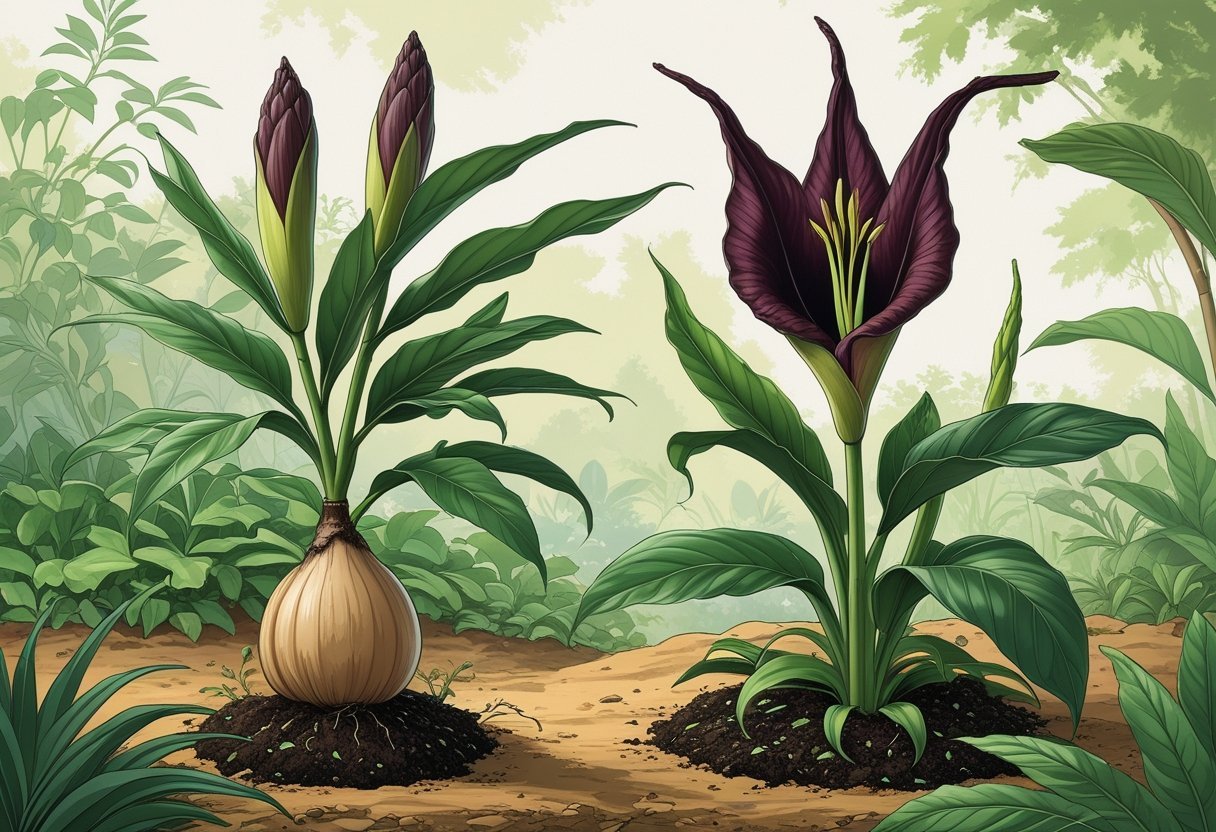The voodoo lily is a real showstopper—big, oddball flowers, wild foliage, and a personality all its own. If you want to pull off growing one, you’ll need to get a handle on its quirks: it likes warmth, steady moisture, and soil that drains well but doesn’t dry out. For best results, plant the tuber in spring somewhere with dappled shade, water it regularly while it’s growing, and let it chill out and go dormant when things cool down.

This plant is happiest in tropical or mild climates, but if you’re gardening somewhere chilly, you’ll want to either dig up the tuber and bring it inside or cover it with mulch to keep it cozy through winter. The voodoo lily’s infamous stink—kind of like a dead animal, if we’re being honest—draws in pollinating flies, which is fascinating in its own weird way. The bloom itself is something to see, but you’ll need to work with its rhythm: a burst of growth, a dramatic flower, then a long nap.
Key Takeaways
- Plant the voodoo lily tuber in warm, well-drained soil with partial shade.
- Keep the soil moist while it’s growing and back off on watering when it goes dormant.
- Protect the plant from cold snaps if you want those wild blooms next year.
Planting and Growing Conditions for Voodoo Lily
The voodoo lily, or Amorphophallus konjac, is a bit particular about where it wants to live. It likes spots with filtered sunlight and soil that drains well—soggy feet are a no-go. If you prep the area and get the corm (that’s the bulb-like thing it grows from) in the right spot, you’re setting yourself up for a pretty reliable perennial.
Choosing a Suitable Location
Partial shade is the name of the game here. Too much direct sun and those big leaves can get scorched, which is a bummer after all that waiting. A spot out of the wind is smart too, since the foliage is surprisingly delicate for such a dramatic plant.
Give it some elbow room, because the voodoo lily can get big—sometimes up to four feet tall and wide. Most folks tuck it somewhere out of the way, since you don’t want people brushing up against it (especially when it’s in bloom).
Soil Preparation and Amendments
Drainage, drainage, drainage. If your soil holds water, mix in some compost or peat moss to fluff it up and help water move through. The roots need air as much as they need moisture.
Rich, loose soil is best. Organic matter keeps things moist but not swampy, and if you’re dealing with heavy clay, a raised bed can be a lifesaver.
Planting the Voodoo Lily Bulb or Corm
You’ll be starting with a corm—sometimes called an elephant yam or devil’s tongue. Don’t bury it too deep; just cover it so the top is level with or barely under the soil.
If you’re growing in a pot, make sure it’s got drainage holes. Water after planting, but don’t drown it. Late spring to early summer is the sweet spot for planting if you want a shot at flowers that year.
Essential Care and Bloom Cycle
Voodoo lilies aren’t exactly high-maintenance, but they do have a routine: careful watering, the right fertilizer, and a little patience as they do their weird on-again, off-again thing.
Watering and Moisture Requirements
Keep the soil evenly moist during the growing season—think wrung-out sponge, not swamp. If the corm sits in standing water, it’ll rot, and that’s the end of the show.
When the leaves start to yellow, that’s your cue to cut back on water. Once it’s dormant, you can pretty much stop watering until you see signs of life again.
In the tropics, you might not need to change much year-round, but in cooler areas, you’ll have to adjust as the seasons change (or if you’re growing it inside for winter).
Fertilizing and Mulching Techniques
A good phosphorus-heavy fertilizer helps the tuber bulk up and makes for better blooms. Feed it every few weeks during the growing season, but don’t go overboard—too much and you’ll just get a pile of leaves.
Mulch is handy for keeping moisture in and the soil temperature even. It also helps protect the corm if you get a cold snap.
If you get tempted to dump on the fertilizer, resist—it’s easy to end up with a leafy plant that never flowers. It’s all about balance.
Understanding the Flowering Process
Here’s the wild part: the voodoo lily flowers before it even puts out leaves, usually in late winter or early spring. The flower is a big maroon spathe wrapped around a spadix, and yes, it really does smell like something crawled in and died.
That stink isn’t just for laughs—it brings in flies to do the pollination. The flower only lasts a day or so, then the big, tropical foliage shows up.
If pollination works out, you’ll see clusters of red berries later. These are kind of cool, but they take their own kind of care if you’re thinking about growing voodoo lilies from seed.
Dormancy and Off-Season Management
After the growth cycle winds down, you’ll notice the plant slipping into dormancy—leaves turn yellow, maybe a little sad, and start to die back. That’s your cue: let the tuber dry out and really ease up on the watering.
If you’re somewhere with chilly winters, you might want to dig up the tuber and stash it somewhere cool and dry—nobody wants a frozen tuber. Folks in tropical spots won’t see as dramatic a dormancy, but it’s still smart to cut back on water.
When late winter rolls around, start watering and feeding again, and the tuber should wake up and get going for another season.




